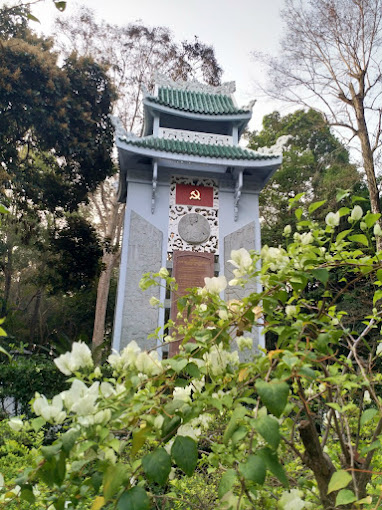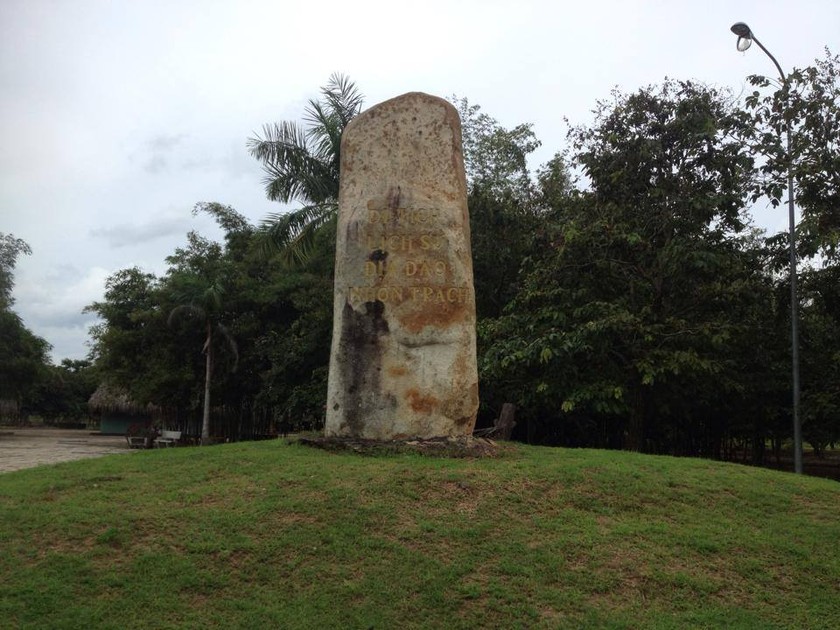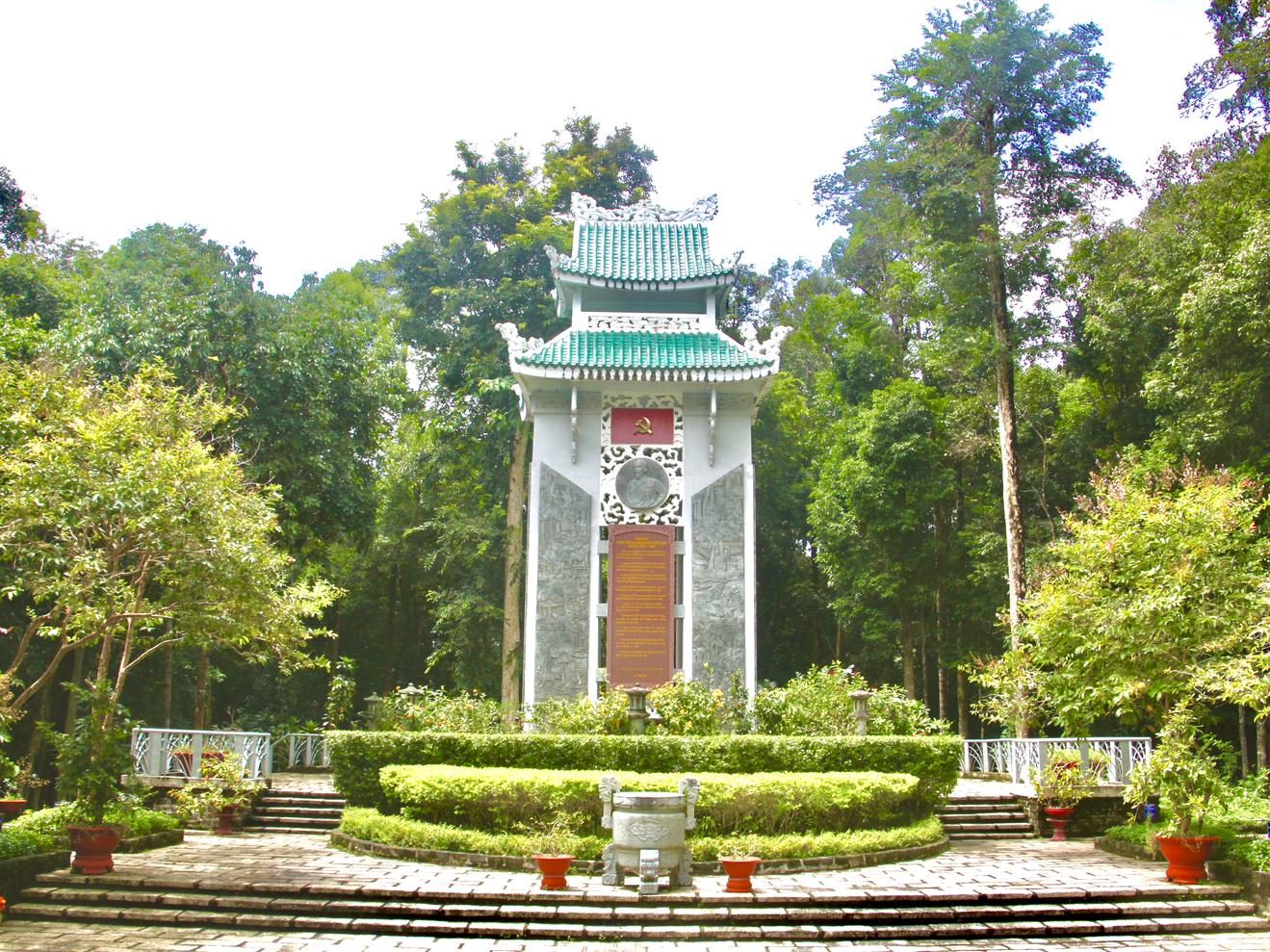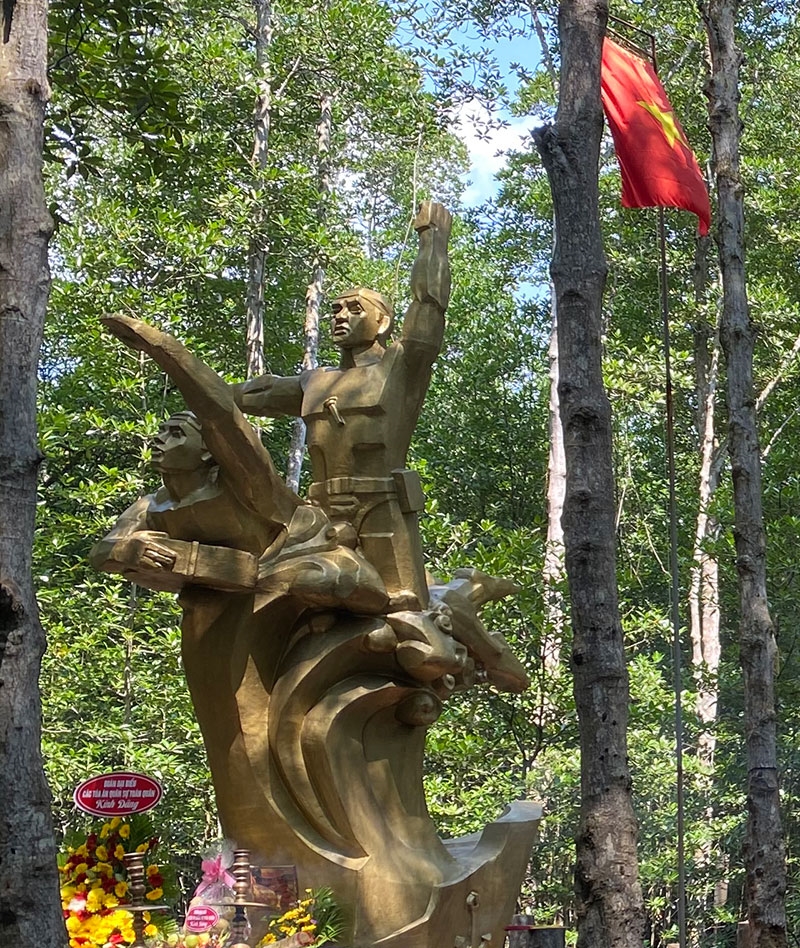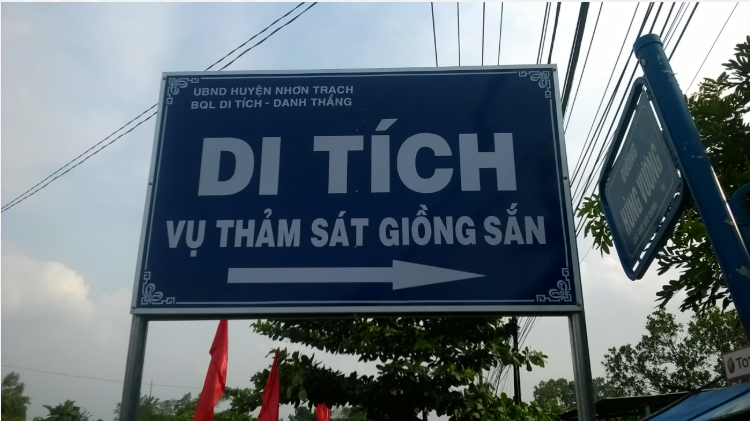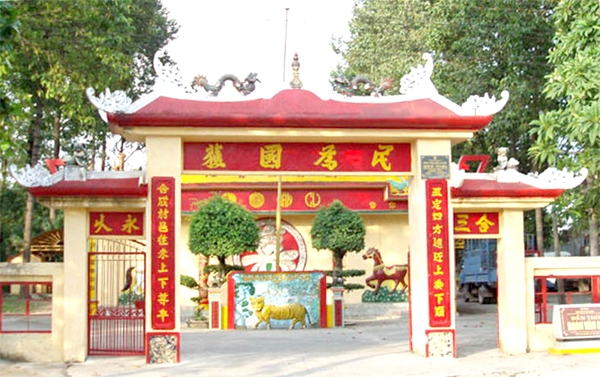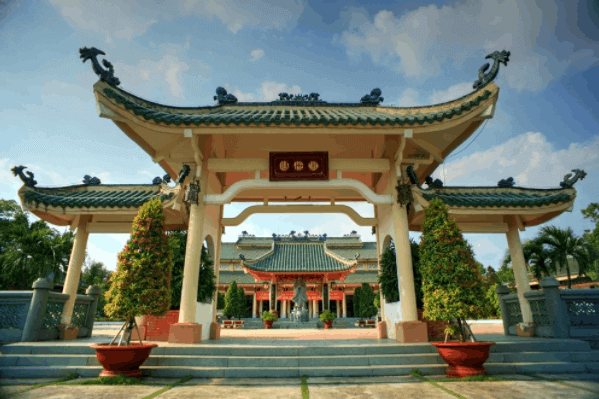Relic point Vietnam
Việt NamHistorical relics location of the Central Base of the Southern Department (1961-1962)
The location of the central base of the Southern Department (1961-1962) was ranked by the Ministry of Culture and Information (now the Ministry of Culture, Sports and Tourism) as a national historical monument under Decision No. 02/2001/Decision -The Culture and Information on January 19, 2001. Currently, the central base of the Southern Department is located in Phu Ly commune, Vinh Cuu district, Dong Nai province. Facing the new request of the revolution, the 3rd National Party Congress set out a strategic task for the South and North. Especially with the Southern Revolution strengthening the direct and comprehensive leadership of the Party Central Committee on the guidelines, guidelines and implementation. On January 23, 1961, the Politburo issued a decision to establish the Central Department of the South and appointed the Executive Committee of 08 comrades led by Mr. Nguyen Van Linh (Muoi Cuc - Secretary of the Central Committee. Mr. Vo Chi Cong (Vo Toan) - Deputy Secretary; Mr. Phan Van Dang (Hai Van) - Deputy Secretary. The Southern battlefield from the 17th parallel. + Organizing Committee - Propaganda: led by Mr. Phan Van Dang - Head of the Board; Comrade Nguyen Van Ngai (Ba Lam, Ba Forest) and Mr. Le Nature - Deputy Head. + Cipher Board: led by comrade Nguyen Van Chin; Comrade Tran Tien Lien and Nguyen Hoang were deputy heads. + Logistics committee: led by Mr. Ly Van Ky; Comrade Nguyen Huu Tan (Nam Moc) was Deputy Head. + Security Committee: The first is called the Central Department of Security Protection Department, later changed to the Central Department of Security Department; led by comrade Pham Thai Buong - Head of the Board; Comrade Cao Dang Chien (Sau Hoang) - Deputy Head. + Regional Military Committee: Commander Tran Quang (Bay Tien); Political Commissar Tran Luong. The task of directing combat, building and developing armed forces, building three troops. + The Banist of Kinh Tai: led by comrade Pham Van Xo (two buckets, two old) heads; Comrade Nguyen Van Phi is the Deputy Head. From this base, the Central Department has built specialized agencies at the Party Committee; set out guidelines and guidelines; directing and leading the people of the Southern Vietnam National Flag during the fierce war to the day the South was completely liberated; With great feats such as victory of Hieu Liem, Phuoc Thanh ... contributing to the beautiful pages of heroic history of the Southern people. Over a long period of existence and development under the devastation of war, nature and people, the central base of the Southern Department is degraded and damaged. In 2004, implementing the direction of the Party Central Committee Secretariat, the Provincial Party Committee and the People's Committee of Dong Nai Province, the restoration and embellishment of the Central Base of the Southern Department with the items: Beer House, Shoch houses, Memorial temples ... in order to preserve and promote the values of monuments and express the moral "Drink water to remember the source" of the Vietnamese nation as the red address for the younger generation to educate today. Source of information portal in Vinh Cuu district, Dong Nai province.
Dong Nai 2102 view
Tunnels Nhon Trach
Nhon Trach Tunnels are located in Hamlet 5, Long Tho Commune, Nhon Trach District, Dong Nai Province, also known as Phuoc An Tunnels because in the past, the monument of Phuoc An commune, Nhon Trach district, Bien Hoa province. It is known that before from mid -1963 until the end of 1964, the tunnel system was dug 1,500m of tunnels with many corner and secret tunnels. The closed continuous tunnel system is designed in the same form as the Chi (Z). The tunnel's backbone is 200m, the corner to the sides to form a functional room for the units. At the middle point at each spine segment (100m) is arranged two vents of the funnel shape. Many designs designed with many straight lines, the length of each section is about 100m. The size of the tunnel from the arch to the bottom fluctuates: 1.8m to 2m high, 1m to 1.2m wide. The roof of the tunnel has a arched structure. The separation between the segments together with a secret compartment has a tight lid, the thickness of the compartment is 1m, which is cut a round hole with a diameter of the body. The main mouth of the tunnel is arranged in the center of the base with a size of 2m length of 1m50, 7m deep into the tunnel spine. The depth of 7m from the ground to the bottom of the tunnel is dug in a sprinkle shape to form stairs. Above the tunnel is the base of the District Party Committee arranged as an equilateral triangle, each side is 70m long with three sides of 2m deep and 1m20 wide transportation to form a closed transportation system. This layout is called in the style of "three -legged", all three trenches are built with 7 battle docks, each with a size of 2m, 3m long, 1m20 deep; Above the tree, the soil is 1m thick, three sides are arranged in three holes. Outside the trench system is arranged two rows of iron and large and large iron and pointed range. Finally, the three layers of zinc fence. Leading into the only base there is a trail located to the northwest of the pan. At this base, Nhon Trach army has made great victories in the years 1965 - 1970. From 1972, Nhon Trach Tunnels became a long -standing place of 500 soldiers and soldiers of the 10th Sac forest, which was a place to start the enemy in the direction of the river, the bomb bomber of Tuy Ha ... causing many heavy losses. With these great values, Nhon Trach Tunnels were recognized by the Ministry of Culture and Information (now the Ministry of Culture, Sports and Tourism) as a national historical and cultural relic on January 19, 2001. Today, Nhon Trach Tunnels are the source of traditional education for the younger generation. Young people come to visit and commemorate the great merits of the ancient father from there to cultivate morality, personality, trying to strive and contribute to deserve the great sacrifice of the previous generation. Source of electronic portal in Nhon Trach district, Dong Nai province.
Dong Nai 2595 view
Based on the Southeastern Party Committee (War Zone Đ)
The Southeastern Party Committee (1962 - 1967) was ranked by the Ministry of Culture and Information (now the Ministry of Culture, Sports and Tourism)) ranked national monuments under Decision No. 3744 -Decision/Ministry of Culture and Information, dated November 29, 1997. In June 1960, the Command of the Armed Forces Liberation of the East (Military Region in the East) and the Eastern Party Committee (T1) was officially established and placed the leadership and commander at the Linh stream (called Base 820) of the War Zone D. The Eastern Party Committee is led by comrade Mai Chi Tho (Tam Cao) as a secretary. Comrade Nguyen Huu Xuyen was appointed commander, Mr. Lam Quoc Dang as Deputy Commander. The agencies of the area are closed along the Linh stream. Here, the Party Committee and the Military Region Command stood foot for a long time, leading the movement and commanding command; Standing place and organizing fighting to protect leaders and commanders. The base area is located on the top of the gravel hill quite flat, the slope is comfortable, an area of over 28ha, a height of 20m above the surface of Linh Linh. The whole hill is covered with dense forest in the Eastern primeval forest system. Part of the base is surrounded by Linh Linh stream all year round, abundant seafood is an endless source of food for the Liberation Army forces. Based on the Party Committee is made up of: The trench system has a total length of 569m, 50 to 60cm deep, 60cm wide fertilizer as three routes (the inner -round defense line and the outer ring and serving the guard and fighting. The continuous tunnel system in the East - North and West - South has a length of over 260m. Stunning door Science, the Southeastern Party Committee is the standing area of the Party Committee, the Military Region Command during 1962 - 1967. From here, the Party Committee, the Military Region Command of the Leadership, Commander of the Armed Forces in collaboration with the Southern main army made the resounding victories such as Phuoc Thanh, Hieu Liem, Binh Gia, Dong Xoai, Dat Hua, Bau San ... USA - Wei, expanding and protecting safety base, preparing all aspects for the General Offensive of Xuan 1968. Over time, in 2001, the Southeast Party Committee relics were restored to the entire appearance including: Tunnels, Hao Traffic System, Hide Bunn, Office ... After restoration and embellishment of relics regularly welcoming many delegations of domestic and foreign guests; The central leaders came to visit and review the heroic tradition of a past historical period. The war has receded, but the Eastern Party Committee base is still a pronunciation of heroic history for the spirit of the noble revolutionary ideals of the Vietnamese nation in the resistance war against the US; The obsession for enemies invading and inspiration for human poetry literature. Source of electronic portal of Vinh Cuu district, Dong Nai province.
Dong Nai 2039 view
Pursuant to the Special Military Region Department of Forest Military Region and the 10th delegation
On April 15, 1966, a special army was established and became immortal with the name of the Hero Sam Sapper Regiment. The Sac forest battlefield spreads over 2,200 hectares, in Nhon Trach and Long Thanh districts (Dong Nai) to H.Can Noi (Ho Chi Minh City). Operating in a very harsh condition, between mangroves, right arms with enemies with equipment and advanced weapons, the soldiers of the 10th Sams of Sac forest only have "passionate patriotic hearts, plus intelligence and fragments, the Gao is crushed" (the words of the Colonel - Hero of the Armed Forces Le Ba Uoc, the former regimental commander of the Military Commission of the 10th Military Commissioner). Over 9 years of clinging, the 10th delegation has made more than 600 battles, completing the goal of controlling the entire system of water supply for Saigon and the South, and at the same time set up great feats in the inner city. More than 900 people have sacrificed, so far more than 500 martyrs have not been found ... Although the terrain and landscape here still retain relatively with the rich flora and fauna system, but because the base is mainly made of rudimentary materials such as coconut leaves, mangrove trunks, after moving to another location, the system of work houses, the workshop facilities of the Special Military Region Headquarters and the 10th Delegation of Sac Sac forest sapper are completely destroyed. On the land of the ancient base, there is a memorial stele, led by Colonel Le Ba Uoc (commander and political commissar of the 10th Special Forest Specialist Youth Union) to commemorate the comrades and soldiers who died in the Sac Sac special military zone. The investment and embellishment of relics contributes to the revolutionary tradition for the younger generation and also to pay homage and gratitude to the heroic martyrs who fought and bravely sacrificed here. Pursuant to the Special Military Region Headquarters of Sac Forest Military Region and the 10th Delegation of Sac Sac sapper in Phuoc An commune, Nhon Trach district, Dong Nai province, which was ranked by the Ministry of Culture, Sports and Tourism ranked by the National Historic Monuments in Decision No. 2105/Decision -Culture and Sports Culture on July 8, 2014. Source of the Ministry of Culture, Sports and Tourism.
Dong Nai 2033 view
Historical relics location of the massacre
On September 23, the Ministry of Culture, Sports and Tourism issued Decision No. 3068/Decision -The Culture and Sports Culture and Tourism Ranking National Monuments for Historical Monuments of the Massacre of Giong San Massacre, Phu Dong Commune, Nhon Trach District, Dong Nai Province. During the anti -American imperialist invasion, the venue of Giong Sung was the place where the massacre of the Saigon government on October 25, 1965 killed 536 civilians and many others were injured. After this event, Nhon Trach District Party Committee held a protest with more than 1,000 participants, opposing the murder of the good people of the Saigon government. The protest caused great indignation in the country, condemning the cruel and brutal of the Saigon army. This massacre also sparked public opinion, reported and condemned by foreign press. To commemorate those who died in the war, in 2004, Nhon Trach district started the construction of Beer - Giong Memorial Park on an area of 15,000m2, this is a monument of marking and denouncing the crimes of the enemy in the massacre of innocent people taking place on Nhon Trach land of Dong Nai province. The venue of Giong Giong was ranked by Dong Nai Provincial People's Committee in 2004. Source of the Ministry of Culture, Sports and Tourism.
Dong Nai 2248 view
Historical relics location of the 125th delegation
The 125th Monument (Suoi Cam hamlet, Long Giao commune, Cam My district), the birthplace of the revolutionary armed forces to unite to save Cambodia and also the resting place of 49 Cambodian soldiers is considered a symbol of Vietnam-Cambodia solidarity. Along with the victory of the anti -American resistance war of the Vietnamese people, the capital of Phnom Penh of Cambodia was also liberated on April 17, 1975. However, shortly after that, the Cambodian revolution entered the dark period because of the genocide of the Red Me Me Me-Yeng Sari Group. Facing that situation, with the help of Chi Nghia, the affection of the Party, the State and the people of Vietnam, the true revolutionary soldiers of Cambodia, including the current Prime Minister of the Kingdom of Cambodia, Samdec Hun Sen, went to Vietnam to build forces, fighting the Khac Kho Me Red Government. On 12/5/1978, at Suoi Cam hamlet, Long Giao commune, Cam My district, the predecessor of the revolutionary armed forces united to save the country of Cambodia - the 125th delegation was established, led by Mr. Hun Sen as the commander. In the process of performing the mission, 49 soldiers of the 125th delegation died here. Along with other patriotic forces of Cambodia, the 125th delegation developed into a mighty army, overthrowing the Pol Pot government, liberating the people and the country of Cambodia to escape the genocide. On January 2, 2012, under the chairmanship of the Prime Minister of Vietnam Nguyen Tan Dung and the Prime Minister of Cambodia Hun Sen, the historic site of the 125th delegation was inaugurated by the Ministry of Culture, Sports and Tourism of Vietnam that was recognized as a national historical and cultural relic area. Source of Dong Nai Electronic Portal.
Dong Nai 2117 view
Tombs, temples of Doan Van Cu and 16 Nghia Binh Thien Dia Hoi
Mo Do Doan Van Cu and 16 Nghia Binh Thien Dia Hoi is located on the Binh Dia area of Long. Binh, Long Binh Ward, Bien Hoa City. This is the burial place of Doan Van Cu, the leader of the Heavenly Association in Bien Hoa and 16 Nghia Binh stood up the resistance against the French army. The temple has a beautiful architecture, including the Vo Ca and the main hall, which is a place to commemorate and pray for Doan Van Cu and his soldiers. The tomb and temple of Doan Van Cu were ranked by the Ministry of Culture and Information of the National Cultural and Cultural Monuments in Decision No. 722/Decision -The Culture and Sports Culture on April 25, 1998. The monument consists of two parts: tombs and temples. The tomb is the burial place for the patriotic house Doan Van Cu, the closed leader of "Heaven and Earth" in Bien Hoa and 16 Nghia Binh Tu battle in the attack of France to carry the palanquin in 1905. This is the place where the resistance base of the "Heavenly Earth" of Bien Hoa. The tomb is located on Binh Dia area, close to the Linh Tuyen stream, about 8 km from the center of Bien Hoa city. Initially just a simple burial tomb; In 1956, the local people were re -built but small scale, until 1990 the new tomb was built like today. The rectangular tomb is 16.5 m long, 2 m wide 0.75 m high, behind is a small temple to worship Doan Van Cu and 16 Nghia Binh. The tomb area is protected by two brick fences, with an entrance, almost surrounding the tomb is the Linh Tuyen stream. The communal house was also built in 1956, about 1km from the tomb to the northeast. The temple is located on a flat, nearly 3000 m2 land area, in Tam Hiep ward, on Highway 15. The temple is built according to Tam Tam architecture (/) consists of two main parts: Vo Ca and the main hall. The martial artist has an area of 303.75 m2 opposite the main temple. Inside there is a small stage used to sing bumper during holidays. A stage opposite the main hall. Before entering the main hall, he had to go to Bai's house. This is the place where the cross goes in and out of the ceremony. Following Bai's house is the main hall; Behind the main hall is a guest house and a kitchen. Doan Van Cu was born in 1835 in Binh An village, Binh An district, Bien Hoa province (now Thu Duc district, Ho Chi Minh City) in a patriotic Confucian family. He led the Heavenly Heavenly Association in Bien Hoa, a patriotic organization against the French. He gathered a large number of insurgents to conduct the resistance war against the French (before the Communist Party was born). In order to prevent the effects and extinguish the movement right from the egg, on the morning of April 12, 1905, a Ma Ta soldier platoon was pulled down by the Sen Dam, the besiege of the palanquin base. The name of Quan Ba and the group of soldiers crossed the stream. At the same time, there was no military guarding the French enemy massively attacked. Doan Van Cu was hit by a sacrifice in front of the altar to worship 16 Nghia Binh. Later, the local people buried him and 16 Nghia Binh and a tomb. Although the time has passed, the fierce example of Doan Van Cu and 16 Nghia soldiers is still a shining example of his love for his sacrifice and the military soldiers who are forever recorded and remembered forever. Source of cultural heritage.
Dong Nai 2175 view
Mo Nguyen Duc Ung and 27 Nghia Binh against the French
From the Vung Tau junction, along Highway 51 connecting Bien Hoa city with Ba Ria - Vung Tau province, the tomb of Leader Nguyen Duc Ung and 27 Nghia Binh against the French is on the left, about 250m from Highway 51, about 7km from the center of Long Thanh district to the south. The monument is the result of the reconstruction in 1936 and the restoration and embellishment later. After restoration and embellishment in 2010, Nguyen Duc Ung's tomb and 27 Nghia Binh were located on a high land area with a total area of 27,402m2, the area in the existing fence was 3,837m2 (of which the construction area was 1,262m2), the land area created a reverse construction space was 4,571m2 and the land leaving the road next to the land area of 570m2. The tomb area has the following location: North borders: Melaleuca land, bamboo bamboo and garden houses. Male: Bordering National Highway 51. East Giap: Melaleuca garden and rice field. Western Giap: Trail - The road traveling in Long Phuoc commune. Overall, the whole grave area is arranged in a main axis, taking the tomb of Nguyen Duc Ung to Highway 51 to form the land with a width of 65m, divided equally on both sides along the main axis. The overall tomb area is arranged in five areas with the following location: Tam Quan gate, reception area: 5,204m2, souvenir tree planting area: area of 2,084m2, Beer house area, Temple: Area of 6,438m2, Main tomb area: Area of 6,502m2. Lanh Binh Nguyen Duc Ung and 27 Nghia Binh sacrificed in the fight to fight the French invading troops on December 26-27, 1861. After Nguyen Duc Ung and his heroic troops sacrificed, the people of Long Thanh sought to bring his corpse and the army of burial in the grave on a high land of the primeval forest, even his French resistance base in Long Thanh commune (now Long Phuoc commune, Long Phuoc district). According to the traditional feng shui concept, the tomb is located on the mound -shaped mound, the sand position, good effects on the settlement of the people residing in the area. Also from here, this land became a place to rest for his thousand years and the soldiers sacrificed for the Fatherland, which could be considered as the first martyrs cemetery of Long Thanh district. Mo Nguyen Duc Ung and 27 anti -French militants were restored in 1936, 1996 and 2010. Architecture built in the overall land in accordance with the general orientation, highlighting the idea of "the martial arts house". The roof of the beer house and the temple bearing the typical roof of Hue royal court, the Nguyen Dynasty. With that value, the tomb area of Nguyen Duc Ung and 27 anti-French military relics has been ranked national historical monuments under Decision No. 2754-Decision /Minister of October 15, 1994. Source of websites in Long Thanh district, Dong Nai province.
Dong Nai 2090 view
Bien Hoa ancient citadel
Located in Quang Vinh Ward, Bien Hoa City, Dong Nai Province. This is considered the only ancient city in the South to exist today. The remaining vestige of the old city is a ring built of laterite surrounding the area of 10,816.5 m², inside there is a French architectural house. Bien Hoa Ancient Citadel also has other names, Cuu, Thanh Trump or Thanh Gas, ancient Thanh Lan village (Tan Lan), Phuoc Chanh district, Bien Hoa province. Initially, Bien Hoa citadel was covered by the people and soldiers of Chan Lap in the 14-15 century. After that, at the beginning of the Nguyen Dynasty, in 1834, King Minh Mang rebuilt with soil, bricks and laterite, in the shape of the bow, building a number of new items, named Thanh Cuu. In 1837, King Minh Mang continued to build and expand into a former laterite of Vauban style, renamed Thanh Bien Hoa. Realizing that the strategic geographical position of Bien Hoa citadel, the French colonialists gathered powerful troops to occupy this citadel. In 1861, the French colonialists conquered Bien Hoa. The Nguyen army was not successful, so he withdrew from Bien Hoa citadel. After occupying the city, the French colonialists have embarked on renovating and narrowing the remaining area of 1/8 compared to before; At the same time, the construction of security and military facilities inside and outside the city, such as: barracks, merchants, military security departments, training grounds, shot beaches, cells, working rooms ...; Arranging high -ranking officers, soldiers to keep, protect and work during the period of colonial rule, colonial exploitation and called the petrol - stone (sola), the local people often called the trumpet. In 1944, Thanh was in control of Japanese fascists. After returning to Indochina for the second time, France used this place to build a family farm. By the period of 1954-1975, Thanh did not have many changes in appearance, the American empire used all the works left by the French colonialists. After 1975, Bien Hoa citadel was taken over by the new government. The remaining traces at Thanh Bien Hoa relic today stand out, the citadel was built of laterite and two French architectural houses. Specifically, the remaining items include: The wall of the city is built mainly from red laterite, tiles with adhesive is lime. The blockbock system currently has a number of bunkers built of laterite and tiles in the eastern corner. The northwestern villa, one of the remaining items of the ancient Thanh Bien Hoa architectural work including 1 ground floor and 2 floors built in the style of French architecture used as the residence and work of French officers. The villa has a solid architectural structure with bearing walls, roofed roofs, steel purlin roofs combined with wooden bridges, tiled floors, brick -rolled linen, ventilated roof doors are done with art aesthetics, technical ingenuity, ensuring good strength for the project. The southeast villa with an area of about 200m2, including 1 ground and 1 floor, used as the residence and work of the French officers at that time. Today, after the last restoration in 2014, the overall monument has become spacious, becoming a sightseeing place to attract tourists from near and far. Experiencing the ups and downs of history, Thanh Bien Hoa relics are witnesses for many events and events in the history of Bien Hoa - Dong Nai. Starting from the fighting between the Kingdoms of Funan, Chan Lap, Cham Pa (1st century) to the war between the Nguyen Dynasty and the Tay Son army (eighteenth century) and later the struggle to defend the country of our people against the French colonialists and the American imperialism. At the same time, this is also considered a rare ancient city project that still exists in the Southern region to this day. In addition, the monument is valuable in many aspects when it is both a special military architecture and a strategic position in the Southeast region of the Nguyen Dynasty; Just reflect the technique of building scientific and architectural lines in the overall items exist. At the same time, show the knowledge of feng shui in the geopolitical way of the ancients. With these historical values, the Ministry of Culture, Sports and Tourism issued Decision No. 3995/Decision -The Culture and Sports Culture and Tourism on November 12, 2013 to recognize Bien Hoa Citadel as a national historical monument. Source of portal port of Bien Hoa city, Dong Nai province.
Dong Nai 2211 view
Tran Bien Temple
Tran Bien Temple is currently located in Buu Long Ward, Bien Hoa City, Dong Nai Province. The history of Tran Bien Temple is associated with the opening of the southern world of the Nguyen Lords. In 1698, Lord Nguyen Phuc Chu sent Nguyen Huu Canh to the Kinh of Dong Nai and merged this land into Vietnam. 17 years later, in 1715, Lord Nguyen Phuc Chu built Tran Bien Temple of Literature, to show the thought of honoring Confucianism, promoting the tradition of respect, respectful talent and continuing the Vietnamese cultural tradition in the South. The work had twice the major restoration was in 1794 under Lord Nguyen Phuc Anh, and in 1852 during the King Tu Duc. In 1861, the French colonialists conquered Bien Hoa and broke this project. It was not until 1998 - to celebrate the 300th anniversary of the establishment and development of Bien Hoa - Dong Nai; Tran Bien Temple of Literature has been restored on the old ground with an area of about 5 hectares, of which the main altar is 2 hectares and completed construction after 4 years. Tran Bien Temple of Literature was restored according to ancient documents such as Dai Nam unanimous, Gia Dinh Thanh Thong Chi. The work items are built symmetrically according to a god axis; In turn, from the outside are Van Mieu Mon, Beer House, Khue Van Cac, Ho Tinh Quang, Dai Thanh Mon, Confucius statue, Ceremony yard, main church. The two sides have the description - Huu is the name of the name - the traditional house, the loincloth - the writer of the loincloth. The building is built with new materials but still follows the traditional style. On Khue Van Cac can see the whole complex of the building. The round door is symbolic for the star Khue (similar to Khue Van Cac in the Temple of Literature - Quoc Tu Giam Hanoi) has been recreated in the Temple of Literature Tran Bien. Behind Khue Van Cac is a wide lake named Tinh Quang. The works here are roofed with Thanh Luu Ly tile (turquoise enamel tile). The works have a harmonious layout. Alternating between constructions is a green tree and many ornamental plants, and the water creates an airy space. Next, after the Tinh Quang Lake is the Great Monk. This is a typical architectural item of the Temple of Literature, leading to the main altar. Dai Thanh Mon has a triangle architecture, tile roof; The two sides have brick walls. After Dai Thanh Mon is the Confucius statue - the ancestor of Confucianism, placed under a roofed architecture, followed by the ceremony and the main church. Confucius statues are carved in monolithic stone, made according to the form from the World Heritage Site (Shandong Province, China). The church is a 7 -space architecture, two wings with 3 floors; There are many ethnic details, inside the columns, trusses and blue, diaphragm and sentences painted with gold. This is the place to worship Vietnamese cultural celebrities. The front is a large yard for ceremonies and organizing cultural events. In the middle of the church is the place to worship President Ho Chi Minh. The left space is the place to place the taste and worship the cultural celebrities associated with the land of Bien Hoa - Dong Nai and the ancient South; On the right is the place to place the tablet and worship the typical cultural celebrity of Vietnam. In front of both sides of the church are: Van Lo Lo (where to display 4 traditional craft villages of Bien Hoa - Dong Nai: Copper, carpentry, stone, pottery); Published for writings is a loincloth - a place to display ancient bibliographies, documents, books ... written about the history, culture, people of the land of Bien Hoa - Dong Nai in the past and present. On August 18, 2016, the Ministry of Culture, Sports and Tourism made a decision on national ranking with historical relics of Van Mieu Tran Bien. Tran Bien Temple is a special cultural address in Bien Hoa (Dong Nai). With airy space and unique architecture, bold cultural tradition, studiousness; This place is the organization of many local events such as students for students, spring flower festivals, spring newspapers, poetry festivals, public newspapers, ancestors' visits ... This is a place to preserve, preserve and honor traditional values, a place to commemorate Vietnamese ancestors in the South. Source of portal port of Bien Hoa city, Dong Nai province.
Dong Nai 2214 view
